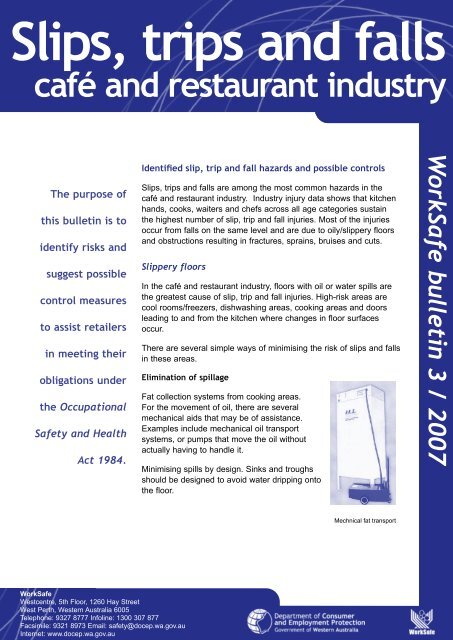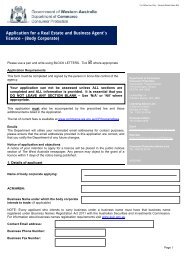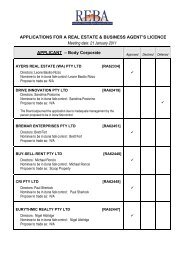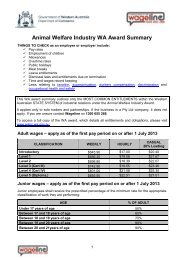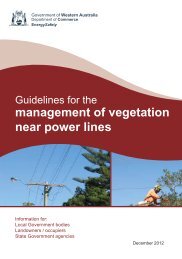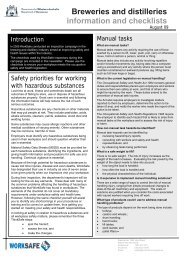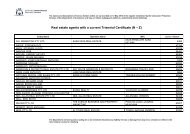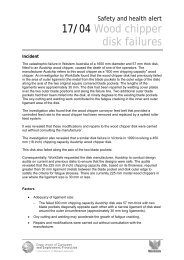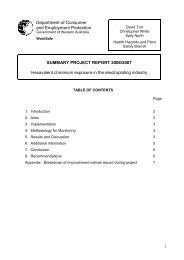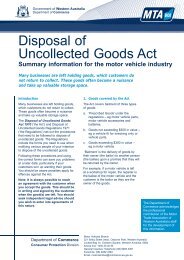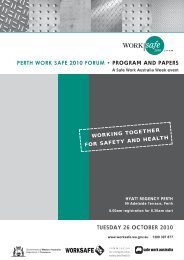Slips trips falls (cafe and restaurant industry)
Slips trips falls (cafe and restaurant industry)
Slips trips falls (cafe and restaurant industry)
You also want an ePaper? Increase the reach of your titles
YUMPU automatically turns print PDFs into web optimized ePapers that Google loves.
<strong>Slips</strong>, <strong>trips</strong> <strong>and</strong> <strong>falls</strong><br />
café <strong>and</strong> <strong>restaurant</strong> <strong>industry</strong><br />
The purpose of<br />
this bulletin is to<br />
identify risks <strong>and</strong><br />
suggest possible<br />
control measures<br />
to assist retailers<br />
in meeting their<br />
obligations under<br />
the Occupational<br />
Safety <strong>and</strong> Health<br />
Act 1984.<br />
WorkSafe<br />
Westcentre, 5th Floor, 1260 Hay Street<br />
West Perth, Western Australia 6005<br />
Telephone: 9327 8777 Infoline: 1300 307 877<br />
Facsimile: 9321 8973 Email: safety@docep.wa.gov.au<br />
Internet: www.docep.wa.gov.au<br />
Identified slip, trip <strong>and</strong> fall hazards <strong>and</strong> possible controls<br />
<strong>Slips</strong>, <strong>trips</strong> <strong>and</strong> <strong>falls</strong> are among the most common hazards in the<br />
café <strong>and</strong> <strong>restaurant</strong> <strong>industry</strong>. Industry injury data shows that kitchen<br />
h<strong>and</strong>s, cooks, waiters <strong>and</strong> chefs across all age categories sustain<br />
the highest number of slip, trip <strong>and</strong> fall injuries. Most of the injuries<br />
occur from <strong>falls</strong> on the same level <strong>and</strong> are due to oily/slippery floors<br />
<strong>and</strong> obstructions resulting in fractures, sprains, bruises <strong>and</strong> cuts.<br />
Slippery floors<br />
In the café <strong>and</strong> <strong>restaurant</strong> <strong>industry</strong>, floors with oil or water spills are<br />
the greatest cause of slip, trip <strong>and</strong> fall injuries. High-risk areas are<br />
cool rooms/freezers, dishwashing areas, cooking areas <strong>and</strong> doors<br />
leading to <strong>and</strong> from the kitchen where changes in floor surfaces<br />
occur.<br />
There are several simple ways of minimising the risk of slips <strong>and</strong> <strong>falls</strong><br />
in these areas.<br />
Elimination of spillage<br />
Fat collection systems from cooking areas.<br />
For the movement of oil, there are several<br />
mechanical aids that may be of assistance.<br />
Examples include mechanical oil transport<br />
systems, or pumps that move the oil without<br />
actually having to h<strong>and</strong>le it.<br />
Minimising spills by design. Sinks <strong>and</strong> troughs<br />
should be designed to avoid water dripping onto<br />
the floor.<br />
Mechnical fat transport<br />
WorkSafe bulletin 3 / 2007
Environmental design<br />
Install non-slip floor surfaces:<br />
➢ Non-slip tiles - especially areas easily contaminated by oil <strong>and</strong> water.<br />
➢ Floor treatments.<br />
➢ Non-slip mats.<br />
➢ Drainage in wet areas.<br />
Engineering controls<br />
For longer distances, trolleys should be used to reduce the risk of spills <strong>and</strong> manual h<strong>and</strong>ling hazards.<br />
Administrative controls<br />
Cleaning floors-effective scheduling <strong>and</strong> adequate frequency.<br />
Transporting fluids- where mechanical aids are not practical, the fluid should be transported in a<br />
suitable container, such as a bucket with sturdy h<strong>and</strong>le <strong>and</strong> secure lid.<br />
Appropriate footwear to be used by persons working in these areas.<br />
Changes in floor levels<br />
There are several simple ways of minimising the risk of <strong>trips</strong> <strong>and</strong> <strong>falls</strong> as a result of changes in floor<br />
levels. These include:<br />
Elimination<br />
Although it is not always practical to eliminate a change in floor levels in an existing kitchen, as part of<br />
a redesign or refit, eliminating this risk factor would be the preferred control option.<br />
Environmental design<br />
Small ramps may be an effective way of graduating the change in floor levels, to reduce the risk.<br />
Administrative controls<br />
Bright markings <strong>and</strong> warning signs are examples of how changes in levels may be clearly indicated.<br />
When changes in floor levels are combined with changes in surfaces, slippery floors or inadequate<br />
lighting <strong>and</strong> manual h<strong>and</strong>ling tasks, the risk of injury becomes much greater. This risk can be controlled<br />
by ensuring that the lighting is good <strong>and</strong> the floor levels have non-slip tiles <strong>and</strong> non-slip matts. These<br />
areas should be kept clear of fluids or any other obstruction that might cause a person to slip, trip or fall.<br />
Regional offices:<br />
Bunbury (08) 9722 2888 TTY: (08) 9327 8838<br />
Karratha (08) 9185 0900
Obstructions<br />
There are several simple ways of minimising the risk of <strong>trips</strong> <strong>and</strong> <strong>falls</strong> as a result of obstructions. These<br />
include controls such as:<br />
Environmental design<br />
Providing appropriate storage design <strong>and</strong> space:<br />
➢ Where possible, items <strong>and</strong> equipment should be stored in appropriate storage areas <strong>and</strong> not<br />
blocking walkways, emergency exits or restricting access to other items.<br />
➢ Workflow should be considered when designing the access to storage areas.<br />
Housekeeping<br />
Make sure:<br />
➢ Items such as flattened cardboard boxes are not used as floor mats, as they are a slip <strong>and</strong> trip<br />
<strong>and</strong> fall hazard.<br />
➢ Walkways are kept clear of obstacles especially during peak work times.<br />
➢ Waste/rubbish is removed regularly from work areas.<br />
Reducing other slip, trip <strong>and</strong> fall hazards<br />
Make sure:<br />
➢ All floor surfaces are stable, even <strong>and</strong> non-slip.<br />
➢ A regular cleaning procedure is in place to keep floors clean of spilt water, oil <strong>and</strong> fat.<br />
➢ Lighting levels are adequate.<br />
➢ Signs are visible to warn employees <strong>and</strong> customers of slippery floors.<br />
What the law says<br />
Employers have a responsibility under the Occupational Safety <strong>and</strong> Health Act 1984 (the Act) to<br />
provide <strong>and</strong> maintain a safe working environment. Fulfilling this obligation includes abiding by the<br />
requirement that it is the responsibility of the employer to, as far as practicable:<br />
➢ identify each hazard to which a person is likely to be exposed;<br />
➢ assess the risk of injury or harm to a person resulting from each hazard;<br />
➢ consider the means by which that risk may be reduced; <strong>and</strong><br />
➢ reduce the risk.
Employees have a responsibility under the Act to take reasonable care for their own safety <strong>and</strong> health<br />
<strong>and</strong> that of others.<br />
Occupational Safety <strong>and</strong> Health Regulations 1996 have specific requirements regarding:<br />
➢ Movement around workplaces – Regulation 3.6<br />
➢ Warning signs – Regulation 3.11<br />
➢ Lighting – Regulation 3.13<br />
➢ Surfaces <strong>and</strong> floors – Regulation 3.18<br />
Penalties<br />
There are serious consequences for individuals <strong>and</strong> organisations resulting from a failure to abide by<br />
the law.<br />
Failure to comply with occupational safety <strong>and</strong> health laws can attract penalties of up to:<br />
➢ $25,000 for employees;<br />
➢ $250,000 for employers; <strong>and</strong><br />
➢ $400,000 for organisations<br />
More information?<br />
Further information on the manual h<strong>and</strong>ling risk management process can be found in the:<br />
➢ Code of practice: Manual h<strong>and</strong>ling; <strong>and</strong><br />
➢ Manual h<strong>and</strong>ling in the café <strong>and</strong> <strong>restaurant</strong> <strong>industry</strong> - Bulletin 4/2007.<br />
Contact WorkSafe on 1300 307 877 for more copies of this document or download it from the<br />
WorkSafe website at www.worksafe.wa.gov.au<br />
This bulletin is available on request in other formats to assist people with special needs.<br />
WorkSafe<br />
WestCentre, 5th Floor, 1260 Hay Street<br />
West Perth, Western Australia 6008)<br />
Telephone: 9327 8777 Facsimile: 9321 8973<br />
Email: safety@docep.wa.gov.au Internet: www.docep.wa.gov.au<br />
<strong>Slips</strong>, <strong>trips</strong> & <strong>falls</strong> in the <strong>cafe</strong> & <strong>restaurant</strong> <strong>industry</strong><br />
bulletin 3 / 2007<br />
DP0295/2007/1 / Mar 07 / 2500


